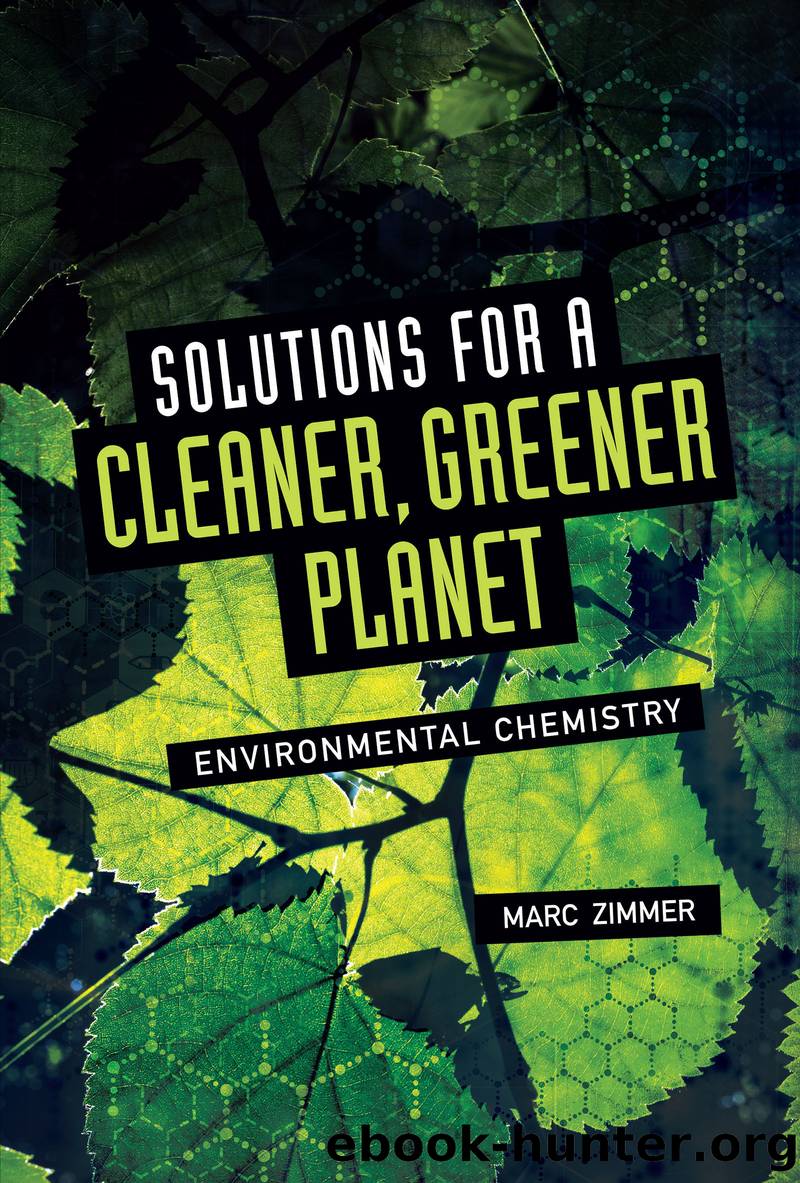Solutions for a Cleaner, Greener Planet: Environmental Chemistry by Marc Zimmer

Author:Marc Zimmer [Zimmer, Marc]
Language: eng
Format: epub
Tags: Atoms, Carbon Dioxide, Chemistry, Chernobyl, Clean Air Act, Clean Water Act, Climate Change, Compounds, Conservation, Ecofriendly, Electrons, Energy, Environment, Environmental Chemistry, Environmental Conservation & Protection, Environmental Protection Agency, Fossil Fuel, Fuel, Fukushima, Green Chemistry, Green Living, Heavy Metals, Marc Zimmer, Neutrons, Nonfiction, Nuclear Chemistry, Nuclear energy, Pesticides, Physical Science, Protection, Protons, Rachel Carson, Recycling, Safe Drinking Water Act, Science & Nature, Solutions for a Cleaner, Greener Planet: Environmental Chemistry, Young Adult Nonfiction, Young Adults
Publisher: Lerner Publishing Group
Published: 2019-01-02T00:00:00+00:00
Forests are natural sinks, which absorb greenhouse gases such as carbon dioxide from the atmosphere. With fewer natural sinks, greenhouse gases are increasing in Earthâs atmosphere.
Scientists measure the concentration of carbon dioxide in the atmosphere in parts per million (ppm), or the number of CO2 molecules in every million molecules of gas. In preindustrial times, the average world CO2 levels were about 280 ppm. In 2016 the levels passed 400 ppm for the first time in four million years. That means that in every one million gas molecules in the atmosphere, at least four hundred are CO2 molecules. Even the carbon dioxide levels at all the South Pole research stations have surpassed 400 ppm.
Most of the worldâs population lives in the Northern Hemisphere, so the greatest volume of carbon dioxide emissions comes from this part of the planet. Carbon dioxide emissions stay in the atmosphere for years because it takes time for the gas to dissolve in seawater and for trees and plants to absorb it. Meanwhile, air currents spread the CO2 all over the world, so carbon emissions are a global problem. âThe increase of carbon dioxide is everywhere . . . if you emit carbon dioxide in New York, some fraction of it will be in the South Pole next year,â said Pieter Tans, a senior scientist with the National Oceanic and Atmospheric Administrationâs Earth System Research Laboratory in Boulder, Colorado.
Correlation of Concentration of Carbon Dioxide and the Global Temperature
Download
This site does not store any files on its server. We only index and link to content provided by other sites. Please contact the content providers to delete copyright contents if any and email us, we'll remove relevant links or contents immediately.
The Science of Philip Pullman's His Dark Materials by Mary Gribbin(219)
Harry Potter and the Sorcerer's Stone: SparkNotes Literature Guide by SparkNotes(198)
Flowers in the Gutter by K. R. Gaddy(189)
Summary of the Selfish Gene by Readtrepreneur Publishing(166)
Super Simple Chemistry by D.K. Publishing(150)
JavaScript Coding for Teens: A Beginner's Guide to Developing Websites and Games by Yueh Andrew(138)
Cracking the AP Economics Macro & Micro Exams, 2017 Edition by Princeton Review(135)
Solutions for a Cleaner, Greener Planet: Environmental Chemistry by Marc Zimmer(132)
The Science of Fashion by Julie Danneberg;(129)
Key Immigration Laws by Kathryn Ohnaka(126)
The Python Audio Cookbook;Recipes for Audio Scripting with Python by Alexandros Drymonitis(125)
Braiding Sweetgrass for Young Adults by Robin Wall Kimmerer(115)
Dark days in Salem: the witchcraft trials by Deborah Kent(115)
Cracking the AP Psychology Exam, 2017 Edition by Princeton Review(113)
Fake News and Propaganda by Fiona Young-Brown(113)
Archaeologists! by Clifford Thompson(108)
Reverse Engineering For Everyone! by mytechnotalent(103)
The Basics of Biochemistry by Kyle Kirkland(99)
DNA and RNA by Jenny Chen(98)
